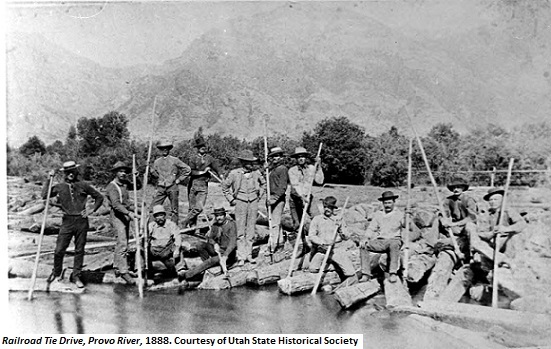Dublin Core
Title
Description
Utah’s mountain ranges were raided and its rivers put to work in order to build the national railroad system.
When the transcontinental railroad came to Utah in 1868 and 1869 – and as branch lines later spread through the territory – railroad builders faced a huge need for wood in order to tie the rails together.
Suitable wood was sparse, except in the forests of the Wasatch and Uinta Mountains. So, how was wood transported from the high mountains down to the construction sites? Roads into the timbering slopes were difficult to build and dangerous to use. Sometimes ice slides were made in winter to get logs to where they could be loaded onto sledges or wagons. But the easier way was to float the wood down the Bear, Provo, and Weber Rivers.
Railroad contractors would send in small crews to cut trees, hack them into the right shape, and stack the newly-hewn ties onto the river banks. During spring runoff, the ties were floated down the rivers to a location where they could be pulled out and transported to the crews laying track. Ties could be floated over 100 miles downriver, with annual “tie drives” lasting up to two months, depending on how long the high water ran.
Sometimes the river banks had to be built up or channeled out in order to keep the ties moving. Men known as “drivers” used poles to loosen jams. Sometimes the logs would be so tightly jammed that a man could walk on them for as much as a mile. The drivers wore hip boots and often worked in water up to their armpits. When the run-off ceased, ties were sometimes stranded until the next season. Utah’s largest tie drive happened around 1886, with 350,000 ties from various companies going downstream.
“Tie drives” were hazardous and made a significant dent in Utah’s forests. Without them, however, the construction of the national railroad network would not have happened.
Creator
Source
Image: The Railroad Tie Drive on Provo River. 1888. Dan Jones, Manager, standing in center. On left, Josiah Smith. On extreme right, Dan Vincent. Courtesy of Utah State Historical Society.
_______________
See Lyndia Carter, "Tieing Utah Together: Railroad Tie Drives” History Blazer, July 1996, accessed at http://historytogo.utah.gov; Alexander Bevan, "Early History of Tooele," in the Joel E. Ricks Collection, Merrill Library, Utah State University, Logan; "Recollections of Henry Goddard about Logging in Provo and Weber Rivers," microfilm, Utah State Historical Society Library; Samuel Stephen Jones Papers, Special Collections, Harold B. Lee Library, Brigham Young University, Provo; Charles S. Peterson and Linda E. Speth, A History of the Wasatch-Cache National Forest, 1903-1980 (Logan: Utah State University, 1980).
Publisher
The Beehive Archive is a production of Utah Humanities. Find sources and the whole collection of past episodes at www.utahhumanities.org
Date
2014-07-11

